#and it's published in like 2001
Explore tagged Tumblr posts
Text
ONCE they were notorious for their furious feuding. Barely a week went by without another angry spat between the brothers grim Noel and Liam Gallagher. But now 3am is happy to announce the sibling rivalry which almost tore Oasis apart has dissolved into - dare we say it - brotherly love. And Noel has cemented this outbreak of chumminess with a magnificent gift for Liam's three-week-old son Gene. Not-so-wicked uncle Noel has put pounds 250,000 into a trust fund for the infant. The gift means that, thanks to investment and interest, by the time he comes of age Gene will be a "trustafarian" millionaire. And it spells a new spirit of accord between Noel, 34, and his kid bro Liam, 28, who was touched to the point of tears. A perfectly placed source told us: "When Noel set up Gene's fund Liam was almost lost for words. It was as if the past rows had never happened. Liam just looked at Noel and said, 'F*** me, man… thanks'. "It was a sweet and tender moment between two guys who are supposed to hate each other's guts." It's a peaceful outcome for a family that was always at war.
The Mirror, July 2001
#print archive stuff#as FOTB immediately asked: did he do something similar for lennon or...#the vibe in all articles of this type that's like: the gallaghers used to fight constantly!#but then they tried this one neat trick and now they'll never ever fight again. :)#and it's published in like 2001
31 notes
·
View notes
Text
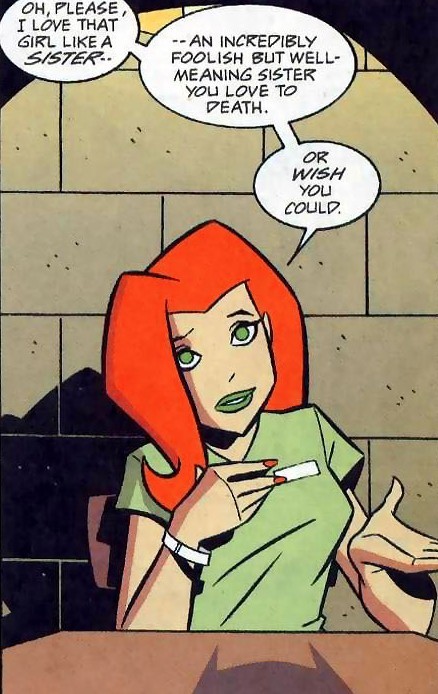
ivy I'm so sorry for the way men write you
#this was published in Dec 2001 and Batgirl Adventures was published in 1998 cmon 😭#ITS THE SAME UNIVERSE THEY FUCK. IT WAS ALREADY CANON THAT THEY FUCK YALL DONT HAVE SIBLINGS WHATS WRONG WITH YOU#''i love her like a sister!'' sir shall hereby be banned from ever touching a female character for the remainder of his career#this is batman gotham adventures 43 btw#btas ivy gets so done dirty in terms of personality consistency#poison ivy#pamela isley#dc comics#harlivy#♧ comic thoughts ♧
104 notes
·
View notes
Text

There’s just something about this photo that emanates such joy and happiness that makes me keep it open on one of my phone’s tabs.
Look at him! He’s just a little guy who’s all too happy to exist!
#Transformers#age of the primes#sky-byte#sky byte#He looks like he just got one of his haikus published#Probably the figure I’m most excited about this year#maccadam#rid 2001#transformers robots in disguise
10 notes
·
View notes
Text
i checked out the princess bride from the library yesterday because i've never read it (or seen the movie lol) but i have heard nothing but praise for it and i hear people reference the movie all the time so i'm gonna try. it is extremely long tho so we'll see if i succeed lmfao
#im hoping it will be goofy and fast paced enough that the length won't be too much of an issue but we'll see#i gave up on erasure because the print was super super tiny and i couldn't focus on it#and as far as i can tell there is no large print edition so i guess i'll have to get an ebook#which is super annoying! that book is from 2001 and was nominated for a pulitzer the publisher has no excuse for no accessible version#but i've noticed that with like 'important' books i.e. pultizer noms are frequently like that#my copy of the secret history is like that too (tho i think that one at least does have a LP available)#bri babbles
4 notes
·
View notes
Text
don't tell pokemon fans about this

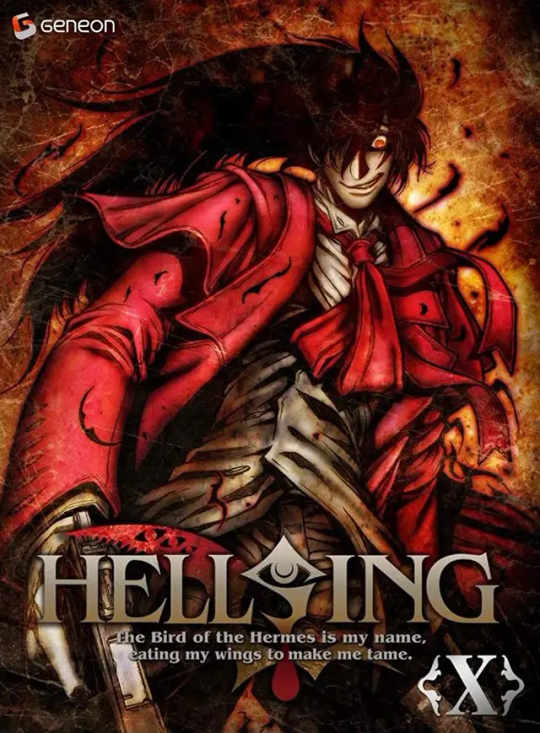


#hazy shitposts#alucard is confirmed to be influenced by vash as kouta hirano is a trigun fan#i'm not sure if vincent valentine is only influenced by vash or if there's a bit of alucard bc ff7 released in early 1997 in japan#and hellsing debuted shortly afterwards#however alucard debuted in a oneshot which was published before hellsing in 1996#so it's not impossible there's a bit of alucard in him#especially since when you first meet him in ff7 he's sleeping in a coffin so like#and dante just follows the general gunslinger in red trope i feel#although i wouldn't be surprised if he was influenced by the others in one way or another#especially vincent since FF7 was such a big game in the late 90s and the original DMC released in 2001 so just 4 years after FF7#anyways the gunslinger in red trope is really really cool
11 notes
·
View notes
Text

doors open is so unserious like for real. why did he say numbers. this equation produces 2010 btw. This means literally nothing because nothing happened in 2010 relating to strangled red afaik .* what the fuck stocks did steven have in 2010. What businesses was he investing in in 2010 . What the fuck did he know that we don't . What was the reason for this. Did he know ?
*other than doors open being released in 2010 which is confusing as fuck why does he reference the year this was written. what. Did he write doors open. Is he the narrator for doors open. what fucking angle was smr going for
#wispy chatters#i will stop now. apologies#not tagging this one ive put two in the strangled red steven tag already.#hidden treat if you check my blog. i guess#also strangled and doors open were published 3 days apart which is funny to me#strangled was first on dec 1st doors open was dec 4th#which.. entirely makes sense that strangled red the prequel and actually well written one was last in publish date#bc iirc strangled red was 2012 so 2 years later.#according to the person who reuploaded strangled SR was 2011. so 2011 or 2012. january 2011 is funny tho bc uh.#if true thats like a month after strangled and doors open. ONE month and the writing quality was so much better#ig strangled red just has a better format bc strangled and doors open r like easter egg game format creepypastas#it wouldve been funnier if he said 2001 because ( COUGHS UP BLOOD
6 notes
·
View notes
Text
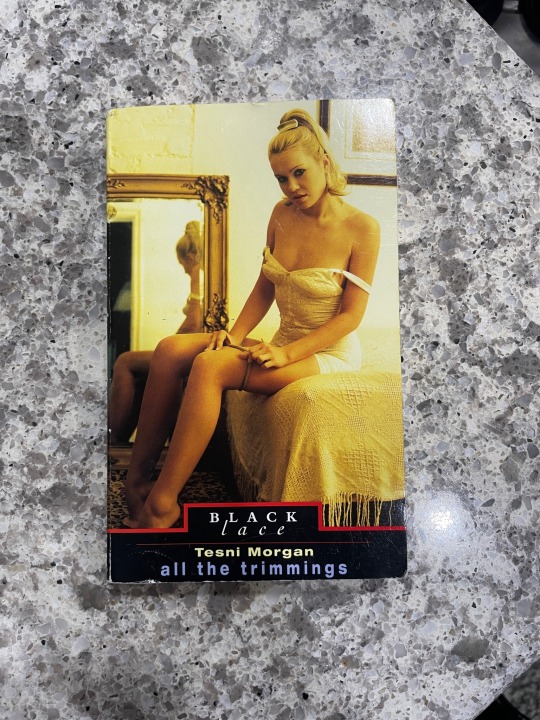

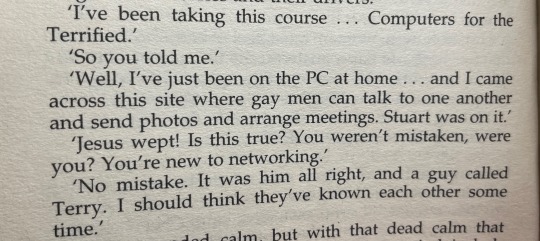
thank you @believerindaydreams this is certainly some dialogue of all time
#published in 2001! they talked about millennium parties!#i was six in 2000 and my mom made us a big chocolate chip cookie with HAPPY MILLENNIUM in blue frosting#as a break from y2k prep!#bc she was convinced her semi-successful ebay bookselling would collapse!#i knew none of this at the time bc i was just baby!#anyway!#this book is like watching a train wreck for straight people. they live like this???
6 notes
·
View notes
Text
basque country having a botanical guide and catalan countries having a botanical guide..... dont mind me im just out here being jealous of these mfs bc we havent had any prominent aragonese botanists since loscos
#z xarre#maybe i should count pedro montserrat as well since he worked a lot in aragon and like. at least one of his kids works in botany as well#here in aragon. but like. we dont have a flora of our own. so we (at least i do) have to check both the basque and the catalan floras#at least the basque book is a bit more manageable size-wise. bc the catalan book is an absolute monster. which makes sense since theres mor#catalan territories. im not sure if vigo and bolòs took into account l'alguer and cat nord and la franja.#but hey thats already catalunya + país valencià + les balears. so it makes sense its bigger#and actually in botany class we worked w the basque flora. i think theres more specific flora like for example im pretty sure#we have a moncayo flora in the same binding as the basque one#and yeah theres other flora books as well but they dont seem as serious as the basque and catalan ones#and then of course theres flora iberica but theyre literally still publishing it if im not mistaken? or the last issue just came out#and if the catalan one was a monster then this one is like.... the boss monster. its huge. and you know the biggest problem?#that its published online for free but the website is from like. 2001 and the selector for families and genuses is absolute dogshit#and worst of all. it doesnt work on firefox mobile so i cant check it on my phone.
0 notes
Text
"Tim Friede’s YouTube channel is home to a collection of videos depicting the Wisconsin-native truck mechanic subjecting himself to purposeful snake bites, blood slowly dripping down his arms.
For the past 20 years, Friede has been one of the most notorious “unconventional” medical researchers, undergoing over 200 bites from the world’s deadliest snakes — and more than four times as many — 850 — venomous injections.
He did it all in the name of science.
According to the World Health Organization, an estimated 100,000 people are killed by snake bites each year, with countless more being disabled by the venom of the deadly reptiles.
While life-saving anti-venom is available, very few countries actually have the capacity to produce it properly, given that most bites occur in remote and rural areas, and anti-venom requires arduous sourcing and accuracy.
But Friede’s blood is now full of antibodies, following decades of strategic exposure to the neurotoxins of mambas, cobras, and other lethal slithering critters.
His blood is now the source material researchers are using to develop an anti-venom capable of neutralizing a broad spectrum of snake bites...
Friede started this hobby — which he is indeed adamant no one else tries at home — out of sheer curiosity in childhood. After playing with harmless garter snakes in his youth, he began keeping more dangerous species of snakes as pets. At one point, he had 60 of them in his home basement.
In 1999, he began extracting venom from his snakes, drying it, diluting it, and injecting himself with tiny doses — keeping meticulous records as he went.
He had one major hospitalization in 2001, when he was paralyzed and in a coma for four days. But instead of giving up, he doubled down.
“In hindsight, I’m glad it happened,” Friede told The Times. “I never made another mistake.”
Jacob Glanville, an immunologist and founder of biotech company Centivax, stumbled on Friede’s videos.
Now, Friede is the director of herpetology at Centivax and serves as something of a “human lab” to Glanville.
“For a period of nearly 18 years, [Tim] had undertaken hundreds of bites and self-immunizations with escalating doses from 16 species of very lethal snakes that would normally a kill a horse,” Glanville told The Guardian.
“It blew my mind. I contacted him because I thought if anyone in the world has these properly neutralizing antibodies, it’s him.”
To develop the new anti-venom, Glanville and his fellow researchers identified 19 of the world’s deadliest snakes — in the elapid family — which kill their prey by injecting neurotoxins into their bloodstream, paralyzing muscles (including the big, important ones, like the heart and lungs).
The trouble is, each species in the elapid family has a slightly different toxin, meaning they would each require their own anti-venom.
But Friede’s blood contains certain fragments of each of these toxins; protein molecules seen across the various species. Because of his decades of service to science, his blood also contains the antibodies required to neutralize these toxins, preventing them from sticking to human cells and causing harm.
Combining the antibodies LNX-D09, SNX-B03, and a small molecule called varespladib that inhibits venom toxins, Centivax has successfully created a treatment effective against the entire range of 19 species’ toxins.
Their work, which was recently published in the journal Cell, will soon be tested outside of the lab.
Trials will start with using the serum to treat dogs admitted to Australian veterinary clinics for snake bites. Assuming that goes well, the next step will be to administer human tests.
Researchers also believe that because the serum stems from a human, this should also lower the risk of allergic reactions when being administered to other people.
“The final product would be a single, pan-anti-venom cocktail,” Professor Peter Kwong of Columbia University, a senior author of the study, told The Times.
Or, he added, they could make two: “One that is for the elapids, and another that is for the viperids, because some areas of the world only have one or the other.”
As for Friede, he maintains his affinity for snakes, though his last bite was in November 2018, when he said “enough is enough,” according to The New York Times.
By then, he had certainly done enough. His pursuit of immunity could feasibly save countless lives.
“I’m really proud that I can do something in life for humanity,” Friede told The New York Times, “to make a difference for people that are 8,000 miles away, that I’m never going to meet, never going to talk to, never going to see, probably.”
-via GoodGoodGood, May 2, 2025
#posting about this again because I found a better article#nothing against the npr article tho#I just don't love posting script format#snake#snakes#tw snakes#herpetology#venomous snakes#medical news#global#good news#hope
7K notes
·
View notes
Text
Okay it's been 24 hours look at my powerpoint slide and laugh with me

wait do people still make those like 'pick your trait' poll memes or whatever where as it goes on each option becomes more and hyper specific to a certain fictional character
#this started as a joke but it kept on going which elevated it from Hilarious to Hysterical#I dare you to find any other two characters that are so absolutely completely different but share this degree of bizarrely specific details#like *bizarrely* specific details#just goes to show personality shapes a character far more than experiences hahaha#the 2001 thing took me completely off guard I would've put hard money down that FMA began publishing before sa2#but nope! came out almost exactly One Month later!#anyways the tags on this post being almost entirely one character or the other with only like 2 people noticing it's Both really tickled me#I hope those of you in both camps have enjoyed inadvertently learning about the other!#thanks for the laughs ya'll hahaha#humming-rambles#the 'hog' bullet comes from aseuki kudos to them for that one that was clever lmao#sonic#fma
866 notes
·
View notes
Text
David Bowie - Space Oddity 1969
"Space Oddity" is a song by the English singer-songwriter David Bowie. It was first released on 11 July 1969 as a 7-inch single, then as the opening track of his second studio album, David Bowie. It is a tale about a fictional astronaut named Major Tom; its title and subject matter were partly inspired by 2001: A Space Odyssey (1968) and Bowie's feelings of alienation at that point in his career. Its sound departed from the music hall of his debut album to psychedelic folk inspired by the Bee Gees; it was one of the most musically complex compositions he had written up to that point. "Space Oddity" is considered one of Bowie's finest recordings and remains one of his most popular songs. It has appeared in numerous "best-of" lists, including the Rock and Roll Hall of Fame's "500 Songs that Shaped Rock and Roll". It was inducted into the Grammy Hall of Fame in 2018.
The label rush-released the single to capitalise on the Apollo 11 Moon mission, which was launched five days later. According to Bowie: "It was picked up by British television and used as the background music for the landing itself in Britain … Though I'm sure they really weren't listening to the lyric at all; it wasn't a pleasant thing to juxtapose against a moon landing. Of course, I was overjoyed that they did." Upon realising the dark lyrics, the BBC ceased playing it until the Apollo 11 crew safely returned home. It initially sold poorly but soon reached number five in the UK, becoming Bowie's first and only chart hit for another three years. Reissues became Bowie's first US hit in 1972, and his first UK number one in 1975. Bowie revisited the Major Tom character in later singles, notably the sequel song "Ashes to Ashes" (1980).
A range of artists have covered "Space Oddity" and others have released songs that reference Major Tom or develop the story of "Space Oddity". In May 2013, the Canadian astronaut and artist Chris Hadfield, commander of Expedition 35 to the International Space Station (ISS), recorded a video of "Space Oddity" while stationed on the ISS that went viral and generated media coverage. It was the first music video to be recorded in space. In the video, filmed towards the end of Hadfield's time on the ISS, Hadfield sang and played guitar while floating around the space station. On Earth, Joe Corcoran produced and mixed the backing track with a piano arrangement by the multi-instrumentalist Emm Gryner, who worked with Bowie during his 1999–2000 concert tours. The lyrics were somewhat altered; rather than losing communication with Ground Control and being lost in space as a result, Major Tom receives his orders to land and does so safely, reflecting Hadfield's imminent return from his final mission to the ISS. The song also mentions the Soyuz spacecraft that Hadfield travelled in. Hadfield announced the video on his Twitter account: "With deference to the genius of David Bowie, here's Space Oddity, recorded on Station. A last glimpse of the World." Bowie's social media team responded to the video, tweeting back to Hadfield, "Hallo Spaceboy …", and later called the cover "possibly the most poignant version of the song ever created".
Hadfield's performance was the subject of a piece by Glenn Fleishman in The Economist on 22 May 2013 analyzing the legal implications of publicly performing a copyrighted work of music while in Earth orbit. "Space Oddity" is the only song of Bowie's for which he did not own the copyright; his publisher granted Hadfield a one-year licence to the song. When the one-year licence expired on 13 May 2014, the official video was taken offline despite Bowie's explicit wishes for the publisher to grant Hadfield a licence at no charge to record the song and produce the video. Following negotiations, the video was restored to Youtube on 2 November 2014 with a two-year licence agreement.
"Space Oddity" received a total of 86,5% yes votes! Previous David Bowie polls: #33 "I'm Afraid of Americans", #235 "Life on Mars?" (and original artist of #118 "The Man Who Sold the World")
youtube
#dylts#dylts poll#finished#high yes#low no#60s#o1#o1 sweep#o1 ultrasweep#o234#lo23#lo24#lo24 tie#lo34#lo2#lo4#david bowie#english
466 notes
·
View notes
Text
When Stockholm’s Traffic Office conducted a general assessment of street traffic in the Swedish capital in 2001, it came to the shocking conclusion that two-thirds of all trees in the city center were dead or dying.
City authorities agreed that an urgent response was needed to nurse these leafy urban ecosystem pillars back to health.
Enter Björn Embrén, Stockholm’s first “tree officer.”
Under his leadership, various technologies and materials were tested in an attempt to create a more suitable living space for trees in the urban environment.
“I knew that they could grow if the circumstances were right,” says Embrén, a former professional gardener.
“It’s like putting a plastic bag over your head and tightening it over your neck,” says Embrén. “That’s what happened to the trees in Stockholm. They were dying.”
Eventually, inspired by railroad embankments — which require only a small amount of organic matter for healthy trees to grow — Embrén concocted what was to become known as the “Stockholm tree pit” model.
By 2002, Embrén had drawn up designs. And by 2003, they were already building.
The design involves digging a pit and constructing a frame underground around the tree’s roots, and then filling said pit with a mixture of soil and stone, sometimes including biochar, to both aerate and fertilize the soil. These permeable layers are very strong and physically adaptable but also allow stormwater to flow in, meaning the trees are provided with sufficient air and water naturally. They also allow rainwater to be soaked up — a necessity amid more extreme weather brought on by climate change.
“We found that the more breathable the materials we used, the happier the trees were,” adds Embrén.
Proponents say the method has a number of benefits, including the fact that pits can be installed around existing trees, they can bear the weight of heavy-vehicle traffic, they require little topsoil — a resource that is becoming scarce — and they need less watering than traditionally-planted trees.
This approach, which allows tree roots to thrive beneath hard surfacing, ergo allowing healthy trees to grow within the modern built environment, is particularly relevant as cities attempt to re-green and reforest in the face of climate change.
According to the United Nations Economic Commission for Europe, urban forests can help “future-proof” cities, which are responsible for about 75 percent of global CO2 emissions. Sustainable urban forestry, it says, can bring multiple benefits, such as lowering temperatures, improving public health, creating habitats for biodiversity, sequestering carbon, generating green jobs, and mitigating risks of floods and landslides.
“It’s more important now than ever before,” says Ryan Klein, an assistant professor in the Department of Environmental Horticulture at the University of Florida. “We have these massive populations in urban areas. And we’re seeing more extreme weather like hurricanes, wildfires and prolonged droughts. Trees can help to offset some of these negative effects.”
However, amid the rush to rapidly reforest cities, experts like Klein warn that due to ineffective methods and techniques being used, it’s common to see urban trees in poor health, and trees planted in cities often have very high mortality rates.
“We have the understanding of how to grow healthier, more sustainable and resilient forests,” says Klein. “The research backs it. Unfortunately, we don’t always invest the time, money or internal know-how on implementing this.”
A review of 16 scientific studies on urban tree mortality, published in 2019, found that in the first five years after planting, 6.6 to 7 percent of trees died annually.
“Urban soils are not very tree-friendly currently,” says Rik De Vreese, leader of the Urban Forestry Team at the European Forestry Institute. “It’s quite a serious threat.”
When trees aren’t properly anchored, De Vreese adds, it can also lead to other issues, such as trunks falling over and causing damage or roots warping sidewalks.
However, the Stockholm Tree Pit method — and the way that it’s been implemented in Sweden — is helping urban forests genuinely take root.
One of the first locations where Embrén introduced a tree pit was Erik Dahlbergsallén street in Stockholm, not far from the popular Swedish Museum of Natural History.
There, according to research by the municipality, the circumference of a selection of those planted trees increased from 30 to 35 centimeters to 70 to 83 centimeters between 2004 and 2013, even surpassing that of trees without the tree pits that have been there for more than 80 years. The latest figures from 2024 saw them reach between 100 and 136 centimeters.
“It’s easy to see how effective the pits have been,” says Embrén.
The municipality estimates that 2.3 million liters of rainwater are managed by the trees per year, and consequently, 4,600 square meters of roofs and sidewalks have been disconnected from the sewage system, reducing the burden on water treatment services.
This technique has proven so successful that it has become the standard for all other development projects in the public spaces of Stockholm. Embrén says he has been directly involved in constructing more than 3,000 tree pits, and while he has since retired, there are now three “tree officers” who have taken on the expanding role.
Britt-Marie Alvem, one of the current tree officers, estimates that the city now builds between 500 and 1,000 tree pits a year.
These days, the tree pits are also in almost every Swedish city — with a few variations.
“Some have copied and changed a little bit, like adding pumice to the stone mix,” says Embrén.
Stockholm’s tree pits are now spreading across Europe, too. In Budapest, Hungary’s capital, the tree pits can be found all over Bartók Béla Boulevard and Arany János Street. Embrén says the Spanish city of Madrid has implemented the method using local materials. And it’s become increasingly popular in the U.K.
Ben Rose, the principal arboricultural consultant at U.K. tree service Bosky Trees and the founder of Stockholm Tree Pits, a U.K.-based company that produces the equipment required to make tree pits, says that he has planted about 500 trees using the Stockholm model in the U.K. since he began in 2019, mostly as part of small-scale pilot projects.
“The approach is very suitable for use in urban situations, particularly in car parks, in plazas, and beside walkways or cycle paths,” says Rose.
Join the Reasons to be Cheerful community by supporting our nonprofit publication and giving what you can. JoinCancel anytime
Yet there are some drawbacks to the system. Installation costs can be high, the pits can require a large amount of space to install, and it is impossible to reuse existing soil. In addition, for now there is a relative dearth of professionals who know how to construct tree pits.
“Our main concern is the price,” says De Vreese, whose team is currently studying the importance of “structural soils” like those deployed by the tree pits. “Excavating the soil surrounding the tree and refilling it is no small job.”
And while Professor Klein praises the Stockholm Tree Pit’s use of structural soil and how effective it’s proven to be, he notes that the long-term success of urban forestry also relies on other factors such as the supply of high quality nursery stock and proactive tree management such as routine pruning by municipalities.
“If we don’t have these we are setting ourselves up for failure,” he says. “Some cities do the bare minimum. In the U.S.A., it’s the wild west. But others, like Stockholm, are proactive, and they have public officials seriously behind it. That’s what we need.”
By: Peter Yeung, March 4, 2025
#urban forests#urban trees#trees#tree pits#stockholm#good news#environmentalism#science#environment#nature#climate crisis#climate change#urban design#urban landscape#urban life#cityscape#city#street#streetscape#urban#soil health#reforestation
451 notes
·
View notes
Text
Sandra Newman’s “Julia”

The first chapter of Orwell's Nineteen Eighty-Four has a fantastic joke that nearly everyone misses: when Julia, Winston Smith's love interest, is introduced, she has oily hands and a giant wrench, which she uses in her "mechanical job on one of the novel-writing machines":
https://gutenberg.net.au/ebooks01/0100021.txt
That line just kills me every time I re-read the book – Orwell, a novelist, writing a dystopian future in which novels are written by giant, clanking mechanisms. Later on, when Winston and Julia begin their illicit affair, we get more detail:
She could describe the whole process of composing a novel, from the general directive issued by the Planning Committee down to the final touching-up by the Rewrite Squad. But she was not interested in the finished product. She 'didn't much care for reading,' she said. Books were just a commodity that had to be produced, like jam or bootlaces.
I always assumed Orwell was subtweeting his publishers and editors here, and you can only imagine that the editor who asked Orwell to tweak the 1984 manuscript must have felt an uncomfortable parallel between their requests and the notional Planning Committee and Rewrite Squad at the Ministry of Truth.
I first read 1984 in the early winter of, well, 1984, when I was thirteen years old. I was on a family trip that included as visit to my relatives in Leningrad, and the novel made a significant impact on me. I immediately connected it to the canon of dystopian science fiction that I was already avidly consuming, and to the geopolitics of a world that seemed on the brink of nuclear devastation. I also connected it to my own hopes for the nascent field of personal computing, which I'd gotten an early start on, when my father – then a computer science student – started bringing home dumb terminals and acoustic couplers from his university in the mid-1970s. Orwell crystallized my nascent horror at the oppressive uses of technology (such as the automated Mutually Assured Destruction nuclear systems that haunted my nightmares) and my dreams of the better worlds we could have with computers.
It's not an overstatement to say that the rest of my life has been about this tension. It's no coincidence that I wrote a series of "Little Brother" novels whose protagonist calls himself w1n5t0n:
https://craphound.com/littlebrother/Cory_Doctorow_-_Little_Brother.htm
I didn't stop with Orwell, of course. I wrote a whole series of widely read, award-winning stories with the same titles as famous sf tales, starting with "Anda's Game" ("Ender's Game"):
https://www.salon.com/2004/11/15/andas_game/
And "I, Robot":
https://craphound.com/overclocked/Cory_Doctorow_-_Overclocked_-_I_Robot.html
"The Martian Chronicles":
https://escapepod.org/2019/10/03/escape-pod-700-martian-chronicles-part-1/
"True Names":
https://archive.org/details/TrueNames
"The Man Who Sold the Moon":
https://memex.craphound.com/2015/05/22/the-man-who-sold-the-moon/
and "The Brave Little Toaster":
https://archive.org/details/Cory_Doctorow_Podcast_212
Writing stories about other stories that you hate or love or just can't get out of your head is a very old and important literary tradition. As EL Doctorow (no relation) writes in his essay "Genesis," the Hebrews stole their Genesis story from the Babylonians, rewriting it to their specifications:
https://www.penguinrandomhouse.com/books/41520/creationists-by-e-l-doctorow/
As my "famous title" stories and Little Brother books show, this work needn't be confined to antiquity. Modern copyright may be draconian, but it contains exceptions ("fair use" in the US, "fair dealing" in many other places) that allow for this kind of creative reworking. One of the most important fair use cases concerns The Wind Done Gone, Alice Randall's 2001 retelling of Margaret Mitchell's Gone With the Wind from the perspective of the enslaved characters, which was judged to be fair use after Mitchell's heirs tried to censor the book:
https://en.wikipedia.org/wiki/Suntrust_Bank_v._Houghton_Mifflin_Co.
In ruling for Randall, the Eleventh Circuit Court of Appeals emphasized that she had "fully employed those conscripted elements from Gone With the Wind to make war against it." Randall used several of Mitchell's most famous lines, "but vest[ed] them with a completely new significance":
https://law.justia.com/cases/federal/appellate-courts/F3/268/1257/608446/
The Wind Done Gone is an excellent book, and both its text and its legal controversy kept springing to mind as I read Sandra Newman's wonderful novel Julia, which retells 1984 from the perspective of Julia, she of the oily hands the novel-writing machine:
https://www.harpercollins.com/products/julia-sandra-newman?variant=41467936636962
Julia is the kind of fanfic that I love, in the tradition of both Wind Done gone and Rosenkrantz and Gildenstern Are Dead, in which a follow-on author takes on the original author's throwaway world-building with deadly seriousness, elucidating the weird implications and buried subtexts of all the stuff and people moving around in the wings and background of the original.
For Newman, the starting point here is Julia, an enigmatic lover who comes to Winston with all kinds of rebellious secrets – tradecraft for planning and executing dirty little assignations and acquiring black market goods. Julia embodies a common contradiction in the depiction of young women (she is some twenty years younger than Winston): on the one hand, she is a "native" of the world, while Winston is a late arrival, carrying around all his "oldthink" baggage that leaves him perennially baffled, terrified and angry; on the other hand, she's a naive "girl," who "doesn't much care for reading," and lacks the intellectual curiosity that propels Winston through the text.
This contradiction is the cleavage line that Newman drives her chisel into, fracturing Orwell's world in useful, fascinating, engrossing ways. For Winston, the world of 1984 is totalitarian: the Party knows all, controls all and misses nothing. To merely think a disloyal thought is to be doomed, because the omnipotent, omniscient, and omnicompetent Party will sense the thought and mark you for torture and "vaporization."
Orwell's readers experience all of 1984 through Winston's eyes and are encouraged to trust his assessment of his situation. But Newman brings in a second point of view, that of Julia, who is indeed far more worldly than Winston. But that's not because she's younger than him – it's because she's more provincial. Julia, we learn, grew up outside of the Home Counties, where the revolution was incomplete and where dissidents – like her parents – were sent into exile. Julia has experienced the periphery of the Party's power, the places where it is frayed and incomplete. For Julia, the Party may be ruthless and powerful, but it's hardly omnicompetent. Indeed, it's rather fumbling.
Which makes sense. After all, if we take Winston at his word and assume that every disloyal citizen of Oceania is arrested, tortured and murdered, where would that leave Oceania? Even Kim Jong Un can't murder everyone who hates him, or he'd get awfully lonely, and then awfully hungry.
Through Julia's eyes, we experience Oceania as a paranoid autocracy, corrupt and twitchy. We witness the obvious corollary of a culture of denunciation and arrest: the ruling Party of such an institution must be riddled with internecine struggle and backstabbing, to the point of paralyzed dysfunction. The Orwellian trick of switching from being at war with Eastasia to Eurasia and back again is actually driven by real military setbacks – not just faked battles designed to stir up patriotic fervor. The Party doesn't merely claim to be under assault from internal and external enemies – it actually is.
Julia is also perfectly positioned to uncover the vast blank spots in Winston's supposed intellectual curiosity, all the questions he doesn't ask – about her, about the Party, and about the world. I love this trope and used it myself, in Attack Surface, the third "Little Brother" book, which is told from the point of view of Marcus's frenemy Masha:
https://us.macmillan.com/books/9781250757531/attacksurface
Through Julia, we come to understand the seemingly omniscient, omnipotent Party as fumbling sadists. The Thought Police are like MI5, an Island of Misfit Toys where the paranoid, the stupid, the vicious and the thuggish come together to ruin the lives of thousands, in such a chaotic and pointless manner that their victims find themselves spinning devastatingly clever explanations for their behavior:
https://www.bbc.co.uk/blogs/adamcurtis/entries/3662a707-0af9-3149-963f-47bea720b460
And, as with Nineteen Eighty-Four, Julia is a first-rate novel, expertly plotted, with fantastic, nail-biting suspense and many smart turns and clever phrases. Newman is doing Orwell, and, at times, outdoing him. In her hands, Orwell – like Winston – is revealed as a kind of overly credulous romantic who can't believe that anyone as obviously stupid and deranged as the state's representatives could be kicking his ass so very thoroughly.
This was, in many ways, the defining trauma and problem of Orwell's life, from his origin story, in which he is shot through the throat by a fascist: sniper during the Spanish Civil War:
https://www.rjgeib.com/thoughts/soldiers/george-orwell-shot.html
To his final days, when he developed a foolish crush on a British state spy and tried to impress her by turning his erstwhile comrades in to her:
https://en.wikipedia.org/wiki/Orwell%27s_list
Newman's feminist retelling of Orwell is as much about puncturing the myth of male competence as it is about revealing the inner life, agency, and personhood of swooning love-interests. As someone who loves Orwell – but not unconditionally – I was moved, impressed, and delighted by Julia.

Tor Books as just published two new, free LITTLE BROTHER stories: VIGILANT, about creepy surveillance in distance education; and SPILL, about oil pipelines and indigenous landback.


If you'd like an essay-formatted version of this post to read or share, here's a link to it on pluralistic.net, my surveillance-free, ad-free, tracker-free blog:
https://pluralistic.net/2024/09/28/novel-writing-machines/#fanfic
#pluralistic#reviews#books#orwell#george orwell#nineteen eighty-four#1984#little brother#fanfic#remix#gift guide#science fiction#sandra newman
703 notes
·
View notes
Text
current list of recent dc wins:
tom taylor leaving nightwing to be replaced by actual competent writer dan watters
joshua williamson leaving green arrow to be replaced by chris cordon whose first storyline is going to be about street level crime in star city
ram v new gods book
currently unannounced ram v project
mark waid dick!robin book🥺
the absolute universe books which actually look.. kind of interesting?? featuring wonder woman not written by a war criminal, wally west & jo mullein? like ok you’ve got my attention!
onyx adams and grace choi joining the bop team
mark waid action comics
mark waid JLU book (jesus mark)
omnibuses of stories like murderer/fugitive, rucka wonder woman, ga 2001
CASSANDRA CAIN SOLO‼️
jeff lemire JSA run with an epic lineup
black lightning solo
tom taylor leaving titans & layman immediately adding roy to the roster
renee montoya series as the question
‘dc’s finest�� publishing which includes parts of bg 2000
in conclusion: im so so happy and so so worried for my bank account
#and on top of all that SPURRIER FLASH IS STILL GOING STRONG💪💪#really our only losses recently have been tt tec and tk dinah. which do suck but compared to all the exciting stuff..
675 notes
·
View notes
Text
I want to tell you a story today.
Let me tell you about how I was finally able to finish a collection of incredibly specific 20+ year old elusive esoteric booklets, after years of looking for them.
No, no, wait, don't scroll past yet. Hear me out.
Is this the most interesting thing ever? It depends. Will it do numbers on tumblr? Not at all. Does this story sound like the statement from someone in The Magnus Archives? Absolutely.
"Statement begins", and all that.
Circa 2001-2002, I was a young girl and asked my dad for a little booklet on witchcraft. As young girls do.
It was part of a collection which was released in newspaper stands and, in my memory, it was something that you had to pay a bit extra to get alongside a specific newspaper, one that is rather informal. My mom also asked for one of the booklets, about past lives. My dad got them both when they released.
I was very interested in my little witchcraft booklet, I found the stuff both fascinating and recognizable. Any Latine can probably tell you about the very particular blend we have, especially in the outskirts of big cities, of brujería, curandería, santería and original people's cultural influences. The book reflected this in a way that sounded familiar and also gave new insights.
One day, though, my booklet disappeared.
I never had evidence of what happened but I had, at the time, a friend from school who was from a very religious family. She kept warning me about the book and how what I was doing was wrong and dangerous and how I would eventually "find Jesus". She just stopped mentioning it once the book mysteriously vanished. So, I don't have hard evidence that my book was taken, but I don't have much doubt.
I grew up and my interest for these types of things evolved to encompass different forms of folkloric and cultural insights, especially on how they represent different social contexts. I have a very particular and maybe conflicting view on spirituality but, in any case, these things interest me.
I also became an editor and I love peculiar publications. The history of publication of something, especially rare, can say a lot about its context.
I ended up reading and buying other books with esoteric themes, but that little booklet resonated still, because I could never find again something that spoke so directly to what I had grown up with.
There are a lot of publications about European and North American practices, very often the most popular folklore calendars are strictly set in the Northern Hemisphere. Some Latine authors tend to blend different things from abroad in their books, rather than talk about just us.
This little booklet was a one of a kind, I realized. In its humble and unapologetic simplicity, it contained the voice of who we were.
So, I set to find it again.
My mom had kept her booklet, the one about past lives. It had the name of the collection in it (Revelaciones), the name of the publisher (Agedit) and a list of all the books in the collection at the end. They were 12 in total. There was not a single author name in sight.
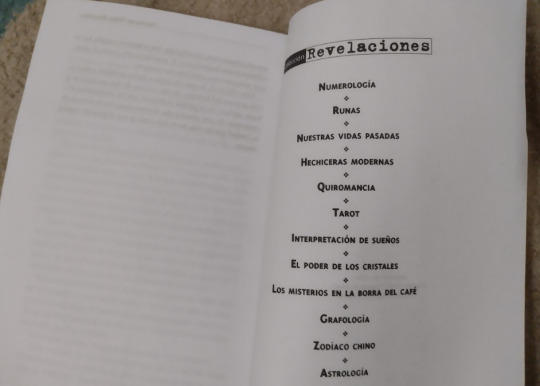
The list includes: Numerology, Runes, Past Lives, Modern Witchcraft (the one I had), Chiromancy, Tarot, Dream Interpretation, Crystals, Tasseography, Graphology, Chinese Zodiac and Astrology.
For a long while, my search only resulted in sold out listings of one or two copies. I also came across additional findings that made my search difficult (this is where I get nerdy in a publishing way):
These books had been out of print for almost 20 years, when I started searching.
These weren't really "books" per se, they were published as such (they had an ISBN) but were sold as if they were magazines.
They were never distributed to bookstores and didn't have any new editions or reprints: they had, most likely, only one print run for each booklet.
The ISBN of the book I had didn't show results online.
I found out the reason for these two points through an archived government official bulletin: the publisher went bankrupt in august of 2003.
Given that there were 12 books, they would have taken between 4 months and a year to complete the collection, depending on how often they came out, so the collection ended shortly before the publisher closed down.
Because of the way in which they were distributed (through newspaper stands) they were given by consignment, meaning the booklets that weren't sold were given back to the publisher when the next issue came out.
Due to the fact that the publisher went bankrupt shortly after, it's highly unlikely that remaining copies were sold as such, it's much more likely that they were sold as paper for re-purpose.
Especially since 2001-2003 was a Bad Time for the economy of Argentina. A Really Bad Time.
The books were edited before the book law changed to make mandatory the use of a bibliographical index, so the books themselves don't have the information now required to register a book printed inside them.
There is not a single author name anywhere.
I found out that the publisher had a very wide variety of magazines of different subjects, including a kids' magazine of the channel I started watching anime in as a kid. Between Captain Tsubasa and cartomancy there's just one step.
So, the only avenues left were patience and book sellers who dealt with used copies of both books and magazines.
After some years of searching, in 2022, the book appeared in two different online sellers: one sold it alone and the other in a set with other 8 books from the collection, including the one my mom had. The book sold alone seemed in worse condition and the set had a lower price per unit.
So, I bought the set of 9.
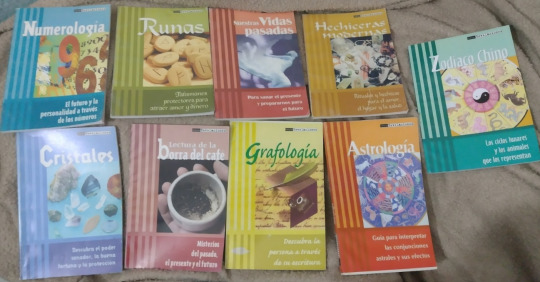
They were in pretty good condition, all things considered. These books were not meant to last. The paper weight vs cover weight ratio is bonkers (the cover is magazine thin), the binding is poor and the books are almost all slightly different sizes. They also have different fonts for the titles. From an editing point of view, they're atrocious.
That only made them so much more interesting to me.
Only one of the books I got in that set had an explicit author: Chinese Zodiac. I assume that one was commissioned to the person whose name appears in it. I did google the man and he doesn't seem to be much of a writer of the subject anymore, he specializes in Tai Chi and Kung Fu, apparently. Seems that his expertise only extended to that one book in particular.
The rest, though. The rest are a mystery.
I don't know if they were written by the publishing team or one person, but they feel like there was one person behind them, for the way they're worded and how they talk to the reader. Or, at least, a different person for different books. They're not detached enough to feel like the work of a team investigation project.
They are also more involved than a newspaper stand collection has any right to be. Talking about Saint Germaine and Cornelio Agrippa and geological specifics of crystal structure. At age 12-13 I wouldn't have paid attention to that but now, knowing what it takes as an editor to put this out and knowing they were a sinking publisher, I've got to respect the craft.
However, the ISBN situation is a NIGHTMARE. The collection changed the ISBN format for these books once every four books.
I could have stopped there. I had my original book, it was just as I remembered, and I got 8 extra books, some with subjects I was very interested in.
However, the tarot book was not included in the set. And that was one I really wanted to get. So, the search continued.
In 2023, my sister gifted me the tarot book. It was from a seller who only had that one and it was in worse shape than the rest. It feels like it was used more than the others. Something was definitely spilled on it. Someone might have learned with it for a long time.
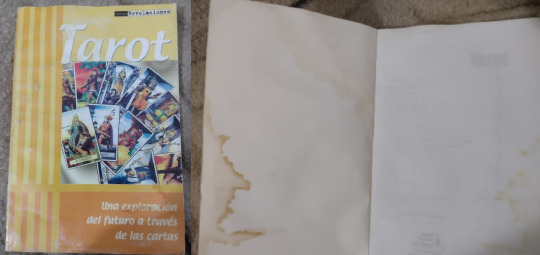
It was very in-character with what I knew from the collection that it focuses solely on Tarot de Marseilles, which is the one most commonly used here (the cover of the book has an RWS deck, so whoever made the cover did not consult with the mysterious author, who used Marseilles iconography inside).
But, again, unnamed author. And the ISBN situation wasn't getting any better. The format of the ISBN in the tarot book matched the one in the crystals book, which gave me an idea of the order list being more or less accurate. Emphasis on "more or less", you'll see.
At this point, I was deep into this. I had 10/12 books, I thought I might as well try to complete the collection, right? How hard could it be?
Well, the two books left were the most elusive of the bunch: chiromancy and dream interpretation.
During my years researching these books, the chiromancy book showed up in pictures just once. I knew what it looked like, but I hadn't seen it for sale. Ever.
That is, until it popped up in early 2024.
I made a post about it at the time. This one was the most expensive of the bunch (not crazy expensive, not even the price of a brand new novel, but expensive in comparison with the others) but it was the first of its kind I had seen in all my years looking, so I got it as soon as I could.
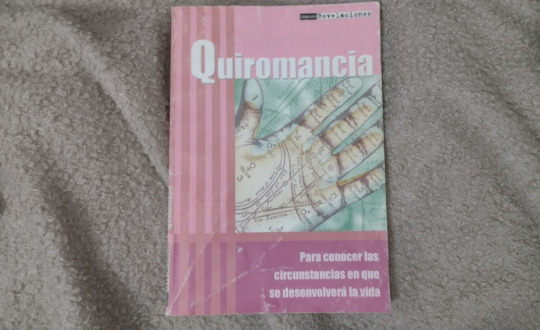
By this time, some repeats had shown up here and there of the books I already had, including a Tarot book in better shape, but I had to draw the line somewhere. There are some that seem to be easier to find than others. Maybe because they were more popular back then, so they didn't get returned to the publisher to turn into pulp.
The dream book though? I still had never seen it.
Not a photo, not an old listing, nothing. I had no frame of reference for what that one looked like, only the title listed in the other books (Interpretación de sueños).
I started losing hope on that one. I started wondering if maybe it had never been released in the first place. Or that maybe it was the most popular one, so people kept it more often than selling it. After all, dream interpretation can be more mainstream a subject than palmistry or tasseography.
The one thing making me doubt that it was unreleased, the one thing keeping me going, was that the last two books on the list (astrology and Chinese zodiac) were listed in an incorrect order until the 11th book. Remember I said the list was "more or less" accurate? Things can't be that simple with this collection.
The list at the end of almost all of the booklets makes me think that astrology was meant to be the last one, but it ended up coming out as the 11th, and they changed the list order upon its release. Maybe the only known author who was commissioned, for the Chinese zodiac book, needed more time to turn in the manuscript.
I thought that, if they had taken the time to change the end list by the 11th book, even if there were only two left, they would have probably removed the dream one had it not come out as planned.
So, it had to exist.
Last week, I was thinking about the books again, as I have done for years, with my hopes of finding the last one almost non existent.
I decided to check in MercadoLibre and wasn't finding it. I went on google and wasn't finding it. I went to google images and nothing. I changed some of the words in the google images search here and there and...
IT SHOWED UP
It had been listed for sale 6 days prior to my search. By a bookstore called "Gluck". My German is beginner-level but I'm pretty sure that means "luck" (at least "glück" does). What are the odds?
The price was pretty cheap but the shipping was a bit steep, so I looked if they had a used copy of Lestat I was looking for, to make up for the shipping cost. I wanted an old Lestat to go with my well-loved 90s edition of IWTV. Turns out, they had an old copy of Lestat, for cheap, because it had what looks like a bite in a corner of the cover. A dog bite, I mean, or cat, not sure which. Perfect. Glück indeed.
So, last week, it finally arrived. The last piece of the puzzle. The dream book.
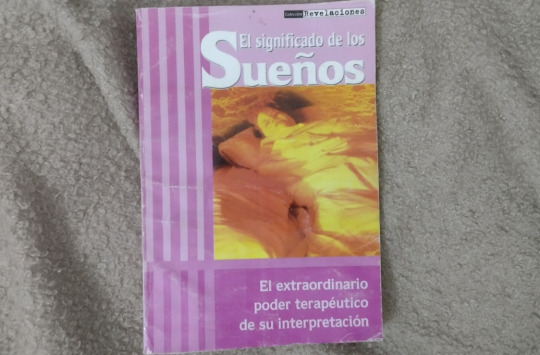
Turns out, the title was wrong all along.
The list had it as Interpretación de sueños and it was actually called El significado de los sueños. No author, but a promising table of contents. It wasn't the subject I was most interested in but the variety of topics covered is a lot more interesting than I expected.
Still, the most important thing here is that I FINALLY HAVE THE WHOLE SET.
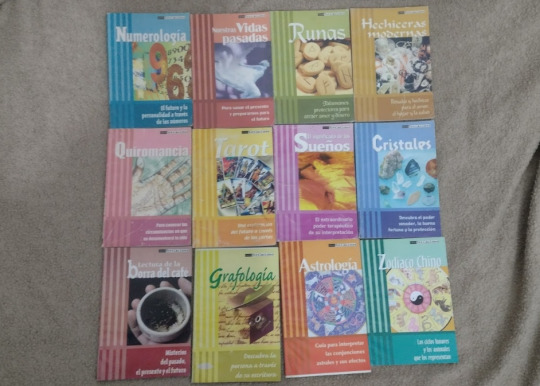
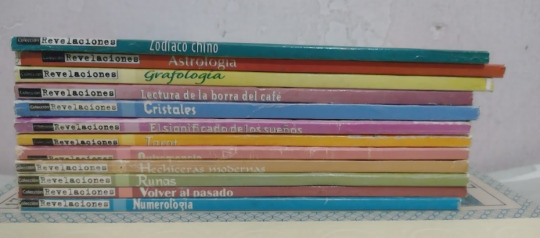
Some insane things about the collection, now that I can look at all of it for myself:
Almost all are mismatched in size
Some have printing mistakes (for example, Astrology has cut marks and extra blank space that wasn't removed)
The last one is wider
The first one doesn't have the list of books
The one about past lives has a different title in the spine than in the book
The one about dreams has a different title in the list than in the book
The one about crystals has a different title in the list than in the book and spine
The one about tasseography has also a different title in the list than in the book and the spine
Most of the cover photos seem to be from different sources, I always believed the one my original book had was taken by the people making the book, because the little owl on it is a Kinder toy I had as a kid
I can now tell you how the ISBN works, so you can look at the madness with me.

The first 4 books have a different ISBN for each, with a change in the part of the ISBN that signifies particular book.
It goes from 8 to 11 and the book with the number 9 is listed as 3rd and not 2nd in the interior list (in my memory, it was 3rd, because that was my mom's book and mine came after, but who knows). All of these have a side bar code with the number 00001.
The next batch of 4 continues having a different ISBN for each book, from books 12 to 15, but the side bar code number also changes, going from 5 to 8, signifying the number of the book in the specific collection.
The last batch of 4 all have the same ISBN, as if they were the same book, with the number 22 (what happened to 16-21? who knows), but they do continue with the side bar code numbers from 9 to 12.
It's wild. I wouldn't have been able to predict anything from this.
Still, here they finally are. I have collected them all. And here's the one that started the interest for this quest.
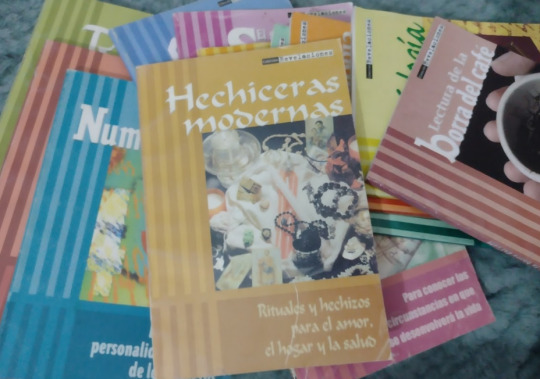
Put together, they constitute a pretty vast amount of pages. The booklets by themselves look rather short but, together, it's a pretty impressive amount of stuff, and quite detailed for each topic.
I still don't know who wrote them, if it was one person or several, or if they even remember working on them, since it's been about 22-24 years since they came out and it seems to have been the dying breath of a now defunct publisher that didn't specialize in the subject.
But I hope that, wherever they may be, they know some people appreciated their work. Because these little messy books have a lot of personality and represent where I come from better than other more polished publications have ever been able to.
#luly rambles#books#long post#book collection#witchcraft#if someone finds this as interesting as I have I love you
196 notes
·
View notes
Text
The Library of Congress (American) gives every literary author a single number for all their works originally written in one language, whatever pseudonym they used.
Seanan McGuire is actually in the schedule (the official list of what numbers mean what and how to make new ones; there are only a few literary authors in each category actually in the schedule) as Mira Grant.
Her number is PS3607.R36395. Let me break that down for you.
PS in American literature in English. (The Library of Congress is... very American.) (PS8001-PS8649 is the Canadian numbers for Canadian literature -- the LOC has agreed not to put anything else there.)
PS700-PS3626 is for works by a single American author who writes in English, literary critiques covering one such author or their works, and biographies covering one such author (this includes things like speeches, because the LOC defines "biography" expansively).
PS3600-PS3626 is for American authors who write in English and were first published in or after 2001, as well as all the other stuff about individual authors like that.
PS3607 is for American authors who write in English, were first published in or after 2001, and have surnames that begin with G. (Remember, McGuire is under Mira Grant.) (And all the other stuff about individual authors like that.)
PS3607.R indicates that the second letter of the author's surname is R.
PS3607.R36395 means precisely "The person who published in this language, place, and time under the name Mira Grant". The string of digits after the R was chosen to make that name file alphabetically in the Library of Congress' catalog with all the other authors. This contains books by and about Seanan McGuire.
Within that number, most of the individual books will have numbers that look like PS3607.R36395 E94 2016. This is a book by McGuire -- it's meant to be a first-edition copy of Every Heart a Doorway -- so the second "cutter" -- that is, the second set of numbers after the decimal point that begins with a letter, in this case E94, represents the title of the book. The date is the date of publication.
This means that the books will be filed alphabetically by title, and very much not in series order. (Sorry).
If someone else has written a book about Every Heart a Doorway, that will be filed right after Every Heart a Doorway, with a number that looks something like PS3607.R36395 E94333 2017.
You can see that this call number contains all of the Every Heart a Doorway's call number except the date. Right after E94, which represents the title, is a 3. This indicated that the book with this call number is about the book that PS3607.R36395 E94 indicated. The next two 3s represent the beginning of the name of the author of the book about Every Heart a Doorway. (We're pretending this is a book by Nina Baym, who was a scholar of American literature and women's writings, but died in 2018.) Then 2017 would be the date of publication of the book about Every Heart a Doorway.
Remember that all the works by and about Seanan McGuire have to fit in PS3607.R36395. That means that some second cutters can't be used to represent the title of an individual work. If the number is PS3607.R36395 DATE, it's a collection of all of McGuire's works (or all the ones in a specific genre). You probably won't see this until she's dead, which will hopefully not be soon. Collections of some of McGuire's works will be in PS3607.R36395 A6 DATE. If it's in PS3607.R36395 ANUMBER DATE, and the number starts with a digit smaller than 6, it's a translation. If it's in PS3607.R36395 Z458 DATE or later, it's a criticism of McGuire's work as a whole or a biography of McGuire. (Note about Z458 or later -- cutters behave as decimal numbers, so Z46 is "later" than Z458.)
Thanks for coming along with me on this journey! If you're ever poking around an academic library that uses LC classification, I hope some of this is helpful.
291 notes
·
View notes